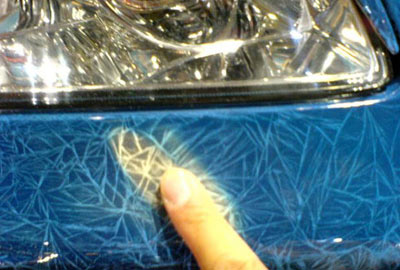 Over the past five decades, the color and composition of automotive coatings have undergone significant transformations, both in base materials and topcoats. By the 1990s, environmental concerns gained global attention, prompting a shift toward water-based automotive coatings. This marked a pivotal change in the industry's approach to sustainability and performance.
Today, car topcoats are typically enamels, known for their high gloss, strong mechanical properties, and excellent weather resistance. High-end vehicles predominantly use resins such as amino, acrylic, alkyd, polyurethane, and solid polyester as base materials. Pigments like titanium white, phthalocyanine, and vibrant organic colors with good weatherability are commonly used. Additives are also incorporated to enhance appearance and performance. However, China still largely relies on solvent-based coatings, while some Western developed nations have already transitioned to water-based alternatives.
China’s automotive coating industry has seen rapid growth, with total production ranking first globally in 2009, making it a major player in the paint market. Despite this, the quality and variety of automotive coatings in China still lag behind international standards. A key challenge lies in the lack of innovative technologies, outdated production methods, and underdeveloped painting equipment. Domestic brands hold only a small share of the market, and intense homogeneity competition has led to shrinking profit margins—on average, less than 10% for many companies. This suggests that there is still substantial room for growth and improvement in the future.
Looking ahead, Zhongan Consultant Coating Research Center outlines several strategic directions for China’s automotive coatings industry:
First, auto paint companies need to rethink their approach and develop a more comprehensive understanding of the entire paint industry. Emphasizing integration between paint formulation and application processes will create new opportunities for innovation and development. Many companies have overlooked the importance of real-world application, and even those aware of this issue still face challenges compared to foreign or joint-venture counterparts.
Second, learning from global experiences while pursuing independent innovation is crucial. While technology and capital imports have played a role in China’s growth, relying solely on foreign brands leaves the industry vulnerable. To build a sustainable and competitive market, Chinese companies must invest in research and development to foster true innovation and secure their own market positions.
Third, embracing internationalization is essential. By leveraging domestic strengths and integrating advanced technologies from around the world, China can enhance its core competitiveness. Collaborations with foreign firms and a focus on innovation will help the industry move toward global standards, ensuring long-term success and growth in the international market.
Over the past five decades, the color and composition of automotive coatings have undergone significant transformations, both in base materials and topcoats. By the 1990s, environmental concerns gained global attention, prompting a shift toward water-based automotive coatings. This marked a pivotal change in the industry's approach to sustainability and performance.
Today, car topcoats are typically enamels, known for their high gloss, strong mechanical properties, and excellent weather resistance. High-end vehicles predominantly use resins such as amino, acrylic, alkyd, polyurethane, and solid polyester as base materials. Pigments like titanium white, phthalocyanine, and vibrant organic colors with good weatherability are commonly used. Additives are also incorporated to enhance appearance and performance. However, China still largely relies on solvent-based coatings, while some Western developed nations have already transitioned to water-based alternatives.
China’s automotive coating industry has seen rapid growth, with total production ranking first globally in 2009, making it a major player in the paint market. Despite this, the quality and variety of automotive coatings in China still lag behind international standards. A key challenge lies in the lack of innovative technologies, outdated production methods, and underdeveloped painting equipment. Domestic brands hold only a small share of the market, and intense homogeneity competition has led to shrinking profit margins—on average, less than 10% for many companies. This suggests that there is still substantial room for growth and improvement in the future.
Looking ahead, Zhongan Consultant Coating Research Center outlines several strategic directions for China’s automotive coatings industry:
First, auto paint companies need to rethink their approach and develop a more comprehensive understanding of the entire paint industry. Emphasizing integration between paint formulation and application processes will create new opportunities for innovation and development. Many companies have overlooked the importance of real-world application, and even those aware of this issue still face challenges compared to foreign or joint-venture counterparts.
Second, learning from global experiences while pursuing independent innovation is crucial. While technology and capital imports have played a role in China’s growth, relying solely on foreign brands leaves the industry vulnerable. To build a sustainable and competitive market, Chinese companies must invest in research and development to foster true innovation and secure their own market positions.
Third, embracing internationalization is essential. By leveraging domestic strengths and integrating advanced technologies from around the world, China can enhance its core competitiveness. Collaborations with foreign firms and a focus on innovation will help the industry move toward global standards, ensuring long-term success and growth in the international market.Check Valve, may be called Backflow Valve, One Way Valve, or Nonreturn valves, they are same product, just differ from names. At Philicflow, we specially design, develop and fabricate all kinds of check valves.
Check Valve, Backflow Valve, One Way Valves, Nonreturn valves
Zhejiang Philic Fluid Control Co.,LTD , https://www.philicflow.com